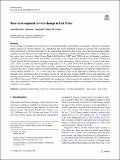| dc.contributor.author | Choi, Yeon-Woo | |
| dc.contributor.author | Campbell, Deborah J. | |
| dc.contributor.author | Eltahir, Elfatih A.B. | |
| dc.date.accessioned | 2023-05-22T17:30:08Z | |
| dc.date.available | 2022-11-28T15:16:42Z | |
| dc.date.available | 2023-05-22T17:30:08Z | |
| dc.date.issued | 2023-05-15 | |
| dc.identifier.uri | https://hdl.handle.net/1721.1/146625.2 | |
| dc.description.abstract | Abstract
In the coming few decades, projected increases in global temperature and humidity are generally expected to exacerbate human exposure to climate extremes (e.g., humid-heat and rainfall extremes). Despite the growing risk of humid-heat stress (measured by wet-bulb temperature), it has received less attention in East Africa, where arid and semi-arid climatic conditions prevail. Moreover, no consensus has yet been reached across models regarding future changes in rainfall over this region. Here, we screen Global Climate Models (GCMs) from CMIP5 and CMIP6 and use, for boundary conditions, simulations from only those GCMs that simulate successfully recent climatic trends. Based on these GCMs and Regional Climate Model (RCM) simulations, we project that annual mean temperature is likely to rise by 2 ℃ toward midcentury (2021–2050) at a faster rate than the global average (about 1.5 ℃), under the RCP8.5 and SSP5-8.5 scenarios, associated with more frequent and severe climate extremes. In particular, low-lying regions in East Africa will be vulnerable to severe heat stress, with an extreme wet-bulb temperature approaching or exceeding the US National Weather Service’s extreme danger threshold of 31 ℃. On the other hand, population centers in the highlands of Ethiopia will receive significantly more precipitation during the autumn season and will see more extreme rainfall events, with implications for flooding and agriculture. The robustness of these results across all GCM and RCM simulations, and for both of CMIP5 and CMIP6 frameworks (CMIP: Coupled Model Inter-comparison Project) supports the reliability of these future projections. Our simulations of near-term climate change impacts are designed to inform the development of sound adaptation strategies for the region. | en_US |
| dc.publisher | Springer Berlin Heidelberg | en_US |
| dc.relation.isversionof | https://doi.org/10.1007/s00382-022-06591-9 | en_US |
| dc.rights | Creative Commons Attribution | en_US |
| dc.rights.uri | https://creativecommons.org/licenses/by/4.0/ | en_US |
| dc.source | Springer Berlin Heidelberg | en_US |
| dc.title | Near-term regional climate change in East Africa | en_US |
| dc.type | Article | en_US |
| dc.identifier.citation | Choi, Yeon-Woo, Campbell, Deborah J. and Eltahir, Elfatih A.B. 2022. "Near-term regional climate change in East Africa." | en_US |
| dc.contributor.department | Parsons Laboratory for Environmental Science and Engineering (Massachusetts Institute of Technology) | |
| dc.contributor.department | Lincoln Laboratory | |
| dc.identifier.mitlicense | PUBLISHER_CC | |
| dc.eprint.version | Final published version | en_US |
| dc.type.uri | http://purl.org/eprint/type/JournalArticle | en_US |
| eprint.status | http://purl.org/eprint/status/PeerReviewed | en_US |
| dc.date.updated | 2022-11-27T04:12:17Z | |
| dc.language.rfc3066 | en | |
| dc.rights.holder | The Author(s) | |
| dspace.embargo.terms | N | |
| dspace.date.submission | 2022-11-27T04:12:17Z | |
| mit.license | PUBLISHER_CC | |
| mit.metadata.status | Authority Work and Publication Information Needed | en_US |

